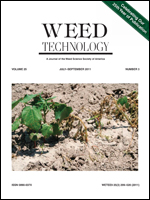Manufacturers of several POST corn herbicides recommend tank-mixing their herbicides with atrazine to improve performance; however, future regulatory changes may place greater restrictions on atrazine use and limit its availability to growers. Our research objectives were to quantify the effects of tank-mixing atrazine with tembotrione compared to tembotrione alone on (1) weed control, (2) variability in weed control, and (3) sweet corn yield components and yield variability. Field studies were conducted for 2 yr each in Illinois, Oregon, Washington, and Ontario, Canada. Tembotrione at 31 g ha−1 was applied alone and with atrazine at 370 g ha−1 POST at the four- to five-collar stage of corn. The predominant weed species observed in the experiment were common to corn production, including large crabgrass, wild-proso millet, common lambsquarters, and velvetleaf. For nearly every weed species and species group, the addition of atrazine improved tembotrione performance by increasing mean levels of weed control 3 to 45% at 2 wk after treatment. Adding atrazine reduced variation (i.e., standard deviation) in control of the weed community by 45%. Sweet corn ear number and ear mass were 9 and 13% higher, respectively, and less variable when atrazine was applied with tembotrione, compared to tembotrione alone. Additional restrictions or the complete loss of atrazine for use in corn will necessitate major changes in sweet corn weed management systems.
Nomenclature: Atrazine; tembotrione; common lambsquarters, Chenopodium album L.; large crabgrass, Digitaria sanguinalis (L.) Scop.; velvetleaf, Abutilon theophrasti Medik.; wild-proso millet, Panicum miliaceum L.; corn, Zea mays L.





